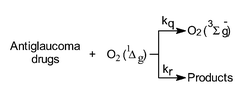Singlet molecular oxygen generation and quenching by the antiglaucoma ophthalmic drugs, Timolol and Pindolol
Abstract
The dye sensitized photooxidation in water (pH 6), of the pharmaceutical topical antiglaucoma drugs, Timolol and Pindolol, which act as β-adrenergic receptor antagonists, were studied by means of static and time-resolved spectroscopic methods and polarographic determinations. O2(1Δg)-mediated photooxidation of Timolol and Pindolol takes place with quantum efficiencies of 0.035 and 0.16, respectively, which raises concern about the possible day-light-mediated photodamaging of the drugs, in the presence of sensitizing agents. Pindolol behaves kinetically as a typical indole derivative, for which the intermediacy of a polar complex is proposed. Solvent effects on the kinetics of photooxidation suggests that the same mechanism could operate for the case of Timolol. Upon direct ultraviolet-light irradiation Timolol and Pindolol generate O2(1Δg), with quantum yields of 0.027 and 0.11 respectively. The former comprises three desirable properties for an external-use ocular drug: a reduced efficiency of O2(1Δg) photooxidation, a relatively high power as O2(1Δg) physical deactivator and a relatively low propensity to O2(1Δg) generation upon direct light irradiation.


 Please wait while we load your content...
Please wait while we load your content...